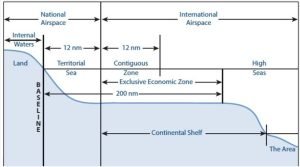Prelims – 2nd Nov 23
Maritime Zones

- Baseline: It is the low-water line along the coast as officially recognized by the coastal state.
- Internal Waters: Internal waters are waters on the landward side of the baseline from which the breadth of the territorial sea is measured.
- Each coastal state has full sovereignty over its internal waters as like its land territory. Examples of internal waters include bays, ports, inlets, rivers and even lakes that are connected to the sea.
- There is no right of innocent passage through internal waters. The innocent passage refers to the passing through the waters which are not prejudicial to peace and security. However, the nations have the right to suspend the same.
- Territorial Sea: The territorial sea extends seaward up to 12 nautical miles (nm) from its baselines.
- A nautical mile is based on the circumference of the earth and is equal to one minute of latitude. It is slightly more than a land measured mile (1 nautical mile = 1.1508 land miles or 1.85 km).
- The coastal states have sovereignty and jurisdiction over the territorial sea. These rights extend not only on the surface but also to the seabed, subsoil, and even airspace. But the coastal states’ rights are limited by the innocent passage through the territorial sea.
- Contiguous Zone: The contiguous zone extends seaward up to 24 nm from its baselines.
- It is an intermediary zone between the territorial sea and the high seas.
- The coastal state has the right to both prevent and punish infringement of fiscal, immigration, sanitary, and customs laws within its territory and territorial sea.
- Unlike the territorial sea, the contiguous zone only gives jurisdiction to a state on the ocean’s surface and floor. It does not provide air and space rights.
- Exclusive Economic Zone (EEZ): Each coastal State may claim an EEZ beyond and adjacent to its territorial sea that extends seaward up to 200 nm from its baselines.
- Within its defined EEZ, a coastal nation has:
- Sovereign rights for the purpose of exploring, exploiting, conserving and managing natural resources, whether living or non-living, of the seabed and subsoil.
- Rights to carry out activities like the production of energy from the water, currents and wind.
- Unlike the territorial sea and the contiguous zone, the EEZ only allows for the above-mentioned resource rights. It does not give a coastal state the right to prohibit or limit freedom of navigation or overflight, subject to very limited exceptions.
High Seas:
- The ocean surface and the water beyond the EEZ are referred to as the high seas. It is considered as “the common heritage of all mankind” and is beyond any national jurisdiction.
- States can conduct activities in these areas as long as they are for peaceful purposes, such as transit, marine science, and undersea exploration.
Botanical Survey of India
- It is the apex research organization under the Ministry of Environment and Forests (MoEFCC) for carrying out taxonomic and floristic studies on wild plant resources of the country. It was established in 1890.
- It has nine regional circles situated at different regions of the country. However the headquarter is in Kolkata, West Bengal.
Zoological Survey of India
- ZSI is also a subordinate organization of the MoEFCC and was established in 1916 as a national center for the faunistic survey and exploration of the resources leading to the advancement of knowledge on the exceptionally rich faunal diversity of the country.
- ZSI has its headquarters at Kolkata and 16 regional stations located in different geographic locations of the country.
